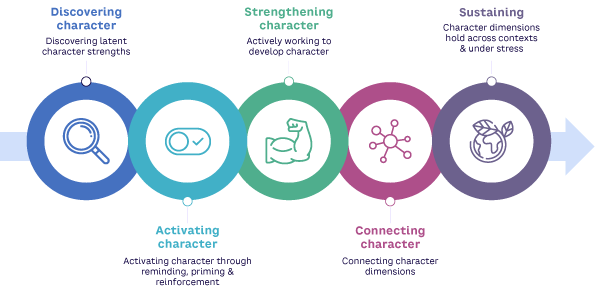AMPLIFY VOL. 37, NO. 1

Leader character is the combination of virtues, values, and traits that enables individuals to lead other people and organizations effectively. However, developing character-based leadership requires intentional dedication, time, and energy, which most leaders have in limited supply. We propose that leveraging mindfulness-based techniques to discover and activate leader character dimensions can create a competitive advantage for leaders and the organizations they lead.
There are many ways leaders can leverage leader character and mindfulness practices as a source of competitive advantage. In this article, we focus on two pathways. The first is leveraging character and mindfulness to promote a “culture of care” that fosters employee well-being. The second is enhancing leaders’ decision-making by incorporating character and mindfulness.
Mindfulness can assist leaders to extend awareness of their leadership behaviors and their consequences, specifically regarding perceptions, responses, actions, and reactions. Practices and interventions aimed at enhancing self-awareness provide leaders and practitioners with practical resources and exercises that shape an avenue for growth and mindful living even when operating in organizational settings. This growth encourages deeper self-discovery and the creation of habitual exercise of virtuous behaviors. Specifically, exercising leader character alongside mindfulness techniques has the potential to enhance leaders’ ability to motivate individuals, groups, and organizations toward the pursuit of their collective objectives and goals.
We propose that leaders’ stress and burnout reduction are the health-oriented mechanisms by which a mindful character-based leadership can drive employees to alter their work-related behaviors and stimulate more collaboration and flexibility. Mindfulness interventions can play a significant role in the future of health and well-being, especially in the everchanging and stressful world for leaders.
Why We Need a Culture of Care in the Post-Pandemic Environment
A 2017 report by the Society for Human Resource Management (SHRM) found there was a US $1-$4 ROI for every dollar invested in workplace well-being initiatives.1 This is not a small figure considering that in 2019 US organizations spent an average of $3.6 million on workplace well-being initiatives.2
This dynamic changed after the pandemic — investing in well-being initiatives is now seen as a way to reduce the resulting high rates of employee absenteeism and turnover.3 A report summarizing data from the US Bureau of Labor statistics shows that in 2022 there were 5.9 million employee separations, 40% of workers changed jobs within the first year of employment, and replacing a full-time employee cost up to twice the amount of that employee’s salary.4
Mental health support and other types of workplace well-being initiatives are no longer seen by employees as perks; they have become an expectation.5 Thus, as the “war for talent” rages on, promoting well-being at work aids companies in attracting and retaining employees, helping to reduce recruitment and streamlining onboarding costs. This article explores what leaders and talent managers can do to sustain leaders’ and employees’ well-being by creating and protecting a culture of caring.
Leader Character as a Competitive Advantage in VUCA Contexts
Character is usually defined as the “the habits of cognition, emotion, and behavior that embody human excellence and produce social betterment.”6 This definition positions character as an important competitive advantage for leaders who wish to have a positive impact on the followers and organizations they lead, in addition to providing an impact in the larger societal context.
We believe leaders can leverage nontraditional approaches to develop their own strength of character while developing character in their colleagues and employees (e.g., collaborators, reports, peers) — see Figure 1.7

Organizational life in the post-pandemic years is increasingly complex. Today, volatile, uncertain, complex, and ambiguous (VUCA) captures the nature of environments in which global organizations operate. A leader who is very effective in managing within a given cultural context (face-to-face workplace, local cultural context) may not be as successful in other global cultural contexts.
However, character is a source of competitive advantage in VUCA contexts. First, the underlying universal principles collected in current leadership character frameworks (e.g., the Ivey Leader Character Framework8 described fully in the previous Amplify issue) are grounded on virtuous ethical principles that tend to transcend cultural contexts and temporal epochs.9
The universal nature of these principles helps leaders make better judgment calls in the face of incomplete or ambiguous information. For example, activating the character dimension of humanity might inform budgetary and operational decisions. Similarly, activating the character dimension of transcendence might future-proof the organization to the changing nature of work. A recent study substantiated the association between leader character and follower well-being.10
Second, certain risk factors can hinder or short-circuit leader’s character-infused decision-making.11 In this article, we focus on the role that stress and anxiety can have on reducing leaders’ quality of decision-making and propose mindfulness-based interventions as countermeasures.
There is ample evidence that this cost-effective approach not only reduces negative emotional states but also increases individuals’ overall well-being.12 Finally, we propose that a leader-tailored version of a mindfulness-based strengths practice (MBSP) program can be a more effective alternative to protect leaders’ mental health (and, thus, their quality of decision-making) than interventions designed for the general population.
Understanding Societal, Organizational & Individual Costs of Workplace Stress
Conditions like depression, anxiety, and chronic stress cause significant strains on society, both from an economic and a well-being perspective. In Canada, mental health issues cost the country about CA $51 billion annually, as reported by the Centre for Addiction and Mental Health (CAMH).13
These illnesses increase work absenteeism and joblessness while causing higher insurance rates and increasing the need for medical treatments and legal advice. According to a CAMH report, people dealing with severe mental illnesses face unemployment rates between 70% and 90%. The report reveals that around 175,000 full-time workers miss work due to mental health reasons each week, with more than 500,000 employed Canadians potentially unable to work because of mental health concerns.14
Stress and anxiety are pervasive among both middle and upper management.15 We believe leaders and managers should consider this as a competitive disadvantage because stress hinders a leader’s ability to make decisions in critical moments as well as their collaborators’ ability to execute them as needed.16
Stress is the body’s natural response to perceived threats or challenges, whether physical, emotional, or psychological. When we encounter it, our bodies release stress hormones like cortisol and adrenaline, which trigger the fight-or-flight response.17 High amounts of stress impact health and are associated with adverse psychological and physiological health effects.18
Stressors include negative life events and chronic work stress and predict increased mortality risk.19,20 An individual’s perception of his or her health status is an important indicator of health outcomes: negative expectations of life events are predictive of poor physical and mental health.21 How we respond to stress has important consequences on our PABC (physiology, affect, behavior, and cognitive) functions, which can lead to an overload of the body’s adaptive mechanisms, and result in negative health outcomes.22
Changing the way that we think about our bodily responses can improve our physiological and cognitive reactions to stressful events.23 Individuals who report having more stress and perceive the stress to affect their health negatively incur the health consequences of an increased allostatic load (the cumulative burden of chronic stress and life events), inciting negative physiological and psychological responses.24 In contrast, when we perceive a situation as a challenge in which we are equipped with the necessary resources to successfully manage, the sympathetic nervous system is activated, causing increased cardiac efficiency, blood flow, and cognitive function.25
Beyond Coping: Mindfulness as Protective Force Against Workplace Stress
Mindfulness, a Western adaptation of an ancient Eastern practice, was popularized in the West by Buddhist monk Thich Nhat Hanh.26 Mindfulness involves the self-regulation of attention with curiosity, openness, and acceptance.27,28 The integration of mindfulness into everyday life is referred to as “mindful living” and is described as a way of life, a means of effecting positive change, and a tool for enhancing well-being and reducing stress.29
Unlike meditation, mindfulness is not about becoming relaxed, breathing in a certain way, or entering a particular state. It is a state of awareness without judgment, purpose, or intent. It is about being present in each moment and observing what is happening within without preconceptions or distortions, helping us connect to our authentic self.
The introduction of mindfulness to Western psychology began with Jon Kabat-Zinn’s collaboration with Thich Nhat Hanh, which led to the development of the first mindfulness-based intervention (MBI) program, known as “mindfulness-based stress reduction” (MBSR), in 1979. Since then, mindfulness has rapidly spread in psychology research and practice, largely due to the success of standardized MBIs.30
MBIs serve as the foundation for various interventions and therapies, such as mindfulness-based cognitive therapy, mindful self-compassion, MBSP, and MBI. Over the past two decades, research on MBIs has grown exponentially with increasing scientific rigor.31 Despite promising findings, empirical research on MBIs in work settings is still new and offers a rich avenue for further investigation.32 Several mindfulness programs have been scientifically validated, offering substantial evidence that mindfulness practices and MBIs can significantly improve mental and physical well-being.33
One of the most well-known and empirically supported MBIs is Kabat-Zinn’s MBSR program. It was initially designed to address physical health and pain, but early participants reported significant stress reduction.34 Mindfulness has been shown to increase our awareness of our internal environment and states, helping us recognize and address self-knowledge gaps.35 It also has the potential to bridge the gap between our perceived self and our aspirational self.36
Given our interest in making leader character a competitive advantage, we turned to the work of Ryan Niemiec, chief science and education officer at the VIA Institute on Character. Niemiec is an expert in the field of positive psychology and has published several books and academic articles connecting character strengths, mindfulness, and well-being. Specifically, we are interested in Niemiec’s MBSP, which is applicable to diverse work contexts and (with some tailoring) could be applied to leadership development. The MBSP was validated by measuring the positive impact of an MBI that combines character strengths (the analog to character elements in the Ivey Leader Character Framework with mindfulness practices like strengths spotting, developing signature strengths, and targeting specific strengths.37
We believe the MBSP could be modified to develop leader character behaviors, based on the findings of MBSP-based research. Character dimensions are made up of character elements that serve as foundational personal resources, which contribute to optimal functioning while in a leadership role.38-40 Specifically, a recent study showed that an MBSP approach is more effective in enhancing employee well-being compared to an MBSR approach.41 Thus, MBSP emerges as a valid intervention for promoting human excellence at work.
Enhancing Leaders’ Decision-Making
Although there is evidence supporting the positive outcomes of MBSP in the workplace, it remains essential to explore the potential benefits that leaders can derive from a dedicated MBSP leadership program. If making a judgment call is the “ultimate act of [organizational] leadership,” then any program that strengthens leaders’ judgment would give them a competitive advantage over leaders who are not aware of their leader character and, thus, may not be optimally exercising their judgment.42
We believe that there are two main pathways by which an MBSP might enhance leaders’ decision-making: alleviating stress through self-awareness and strengthening judgment.
Alleviating Stress Through Self-Awareness
The first pathway involves alleviating stress and anxiety through self-awareness. This would be particularly useful when navigating crisis situations and other leadership crucibles. As stated, there is ample evidence that MBIs help individuals (1) reduce negative emotional states; and (2) develop coping mechanisms to deal with stressful situations.
Protecting leaders’ well-being is not just a peripheral business issue. Research suggests CEO burnout:
-
Is often related to missing crucial cues when making important decisions under stress43
-
Can be a cause of abusive supervisory behaviors44
-
Can negatively affect a firm’s EBITDA (earnings before interest, taxes, depreciation, and amortization)45
Mindfulness can increase leaders’ competitive advantage by protecting them from making poorly informed decisions or undermining their influence by mistreating collaborators, both of which can lead to them hurting their firm’s bottom line.
Strengthening Judgment
The first pathway would prevent leaders from making poor choices, but there is still a need to elicit leader behavior that fosters human excellence and social betterment. We believe an MBSP tailored for leaders would contribute to bringing more than one character dimension to leaders’ stream of consciousness, enhancing decision-making, unleashing innovation, and delivering sustainable and veritable performance to stakeholders.
There is evidence to support this. For example, a 2015 review shows practicing mindfulness at work can elevate one’s everyday experience from cognitive processing and problem solving to complex experiential processing that covers a larger array of situational cues.46
We believe that informing leaders’ decision-making processes with principles of positive leadership will activate their judgment-based character elements. Moreover, their awareness and ability to activate and exercise judgment will enable them to process informational cues more effectively, including their intuition, rational analysis, and situational awareness.47
Strengthening one’s judgment and connecting it with future-oriented character dimensions, such as transcendence, helps leaders consider both the short-term implications of a judgment call and its longer-term consequences. Similarly, connecting judgment to character dimensions like humanity and collaboration can enhance decision-making to ensure the decision protects the interest of stakeholders other than shareholders.
How can leaders strengthen their judgment and connect it with other character dimensions? We believe a leader-tailored MBSP program could help. Such a program would focus on employing mindfulness to discover latent character dimensions and bring them into leaders’ stream of consciousness. In this way, leaders might expand their repertoire of behaviors when rational decision-making is insufficient.
Leaders might find that they have, for example, more courage, integrity, and temperance than they originally thought and incorporate these dimensions into their habitual leadership practice. Similarly, by meditating in a nonjudgmental way on previous situations and crucibles, leaders can activate their humanity. This might result in them being compassionate enough to learn from past mistakes without eliciting negative emotions associated with unaccomplished personal or professional goals.
Conclusion
There are many ways leaders can make character a competitive advantage. One way is ensuring that an organization’s decision makers, and those who will execute their decisions, experience well-being at work. Our premise is that “burnt out” employees are less productive and that MBIs (specifically MBSP) are valid approaches to reduce stress and foster well-being at work. We believe a tailored MBSP solution, targeted for a specific stakeholder group (leaders), can be beneficial not only to protect leaders’ well-being, but to create a competitive advantage by ensuring their collaborators also experience well-being.
References
1 Milligan, Susan. “Employers Take Wellness to a Higher Level.” Society for Human Resource Management (SHRM), 21 August 2017.
2 Starner, Tom. “Are Employers Spending More Now on Employee Wellbeing?” Human Resource Executive, 22 April 2019.
3 Hirsch, Arlene S. “Don’t Let Mental Health Support Weaken Post-Pandemic.” Society for Human Resource Management (SHRM), 29 November 2021.
4 Farrugia, J.D. “7 Statistics on Employee Turnover Every HR Manager Should Be Aware of.” Workforce.com, 13 September 2022.
5 Hirsch (see 3)
6 Crossan, Mary M., et al. “Toward a Framework of Leader Character in Organizations.” Journal of Management Studies, Vol. 54, No. 7, December 2016.
7 Crossan, Mary, Cassandra Ellis, and Corey Crossan. “Towards a Model of Leader Character Development: Insights From Anatomy and Music Therapy.” Journal of Leadership & Organizational Studies, Vol. 28, No. 3, August 2021.
8 Crossan, Mary M., et al. “Toward a Framework of Leader Character in Organizations.” Journal of Management Studies, Vol. 54, No. 7, December 2016.
9 Peterson, Christopher, and Martin E.P. Seligman. Character Strengths and Virtues: A Handbook and Classification. American Psychological Association (APA), 2004.
10 Monzani, Lucas, Gerard H. Seijts, and Mary M. Crossan. “Character Matters: The Network Structure of Leader Character and Its Relation to Follower Positive Outcomes.” PLoS ONE, Vol. 16, No. 9, September 2021.
11 Nguyen, Brenda, and Mary Crossan. “Character-Infused Ethical Decision Making.” Journal of Business Ethics, Vol. 178, March 2021.
12 Monzani, Lucas, et al. “Blending Mindfulness Practices and Character Strengths Increases Employee Well-Being: A Second-Order Meta-Analysis and a Follow-Up Field Experiment.” Human Resource Management Journal, Vol. 31, No. 4, May 2021.
13 “Mental Illness and Addiction: Facts and Statistics.” Centre for Addiction and Mental Health (CAMH), accessed January 2024.
14 CAMH (see 13).
15 Harter, Jim. “Manager Burnout Is Only Getting Worse.” Gallup, 18 November 2021.
16 Mano, Haim. “Judgments Under Distress: Assessing the Role of Unpleasantness and Arousal in Judgment Formation.” Organizational Behavior and Human Decision Processes, Vol. 52, No. 2, July 1992.
17 Russell, Georgina, and Stafford Lightman. “The Human Stress Response.” Nature Reviews Endocrinology, Vol. 15, June 2019.
18 Keller, Abiola, et al. “Does the Perception That Stress Affects Health Matter? The Association with Health and Mortality.” Health Psychology, Vol. 31, No. 5, September 2012.
19 Keller et al. (see 18).
20 Poulin, Michael J., et al. “Giving to Others and the Association Between Stress and Mortality.” American Journal of Public Health, Vol. 103, No. 9, September 2013.
21 Keller et al. (see 18).
22 Crossan, Mary, Cassandra Ellis, and Corey Crossan. “The Role of Physiology, Affect, Behavior and Cognition in Leader Character Activation: A Music Intervention.” Journal of Character and Leadership Development, Vol. 10, No. 2, Summer 2023.
23 Jamieson, Jeremy P., Matthew K. Nock, and Wendy Berry Mendes. “Mind Over Matter: Reappraising Arousal Improves Cardiovascular and Cognitive Responses to Stress.” Journal of Experimental Psychology General, Vol. 141, No. 3, September 2011.
24 Keller et al. (see 18).
25 Jamieson et al. (see 23).
26 Niemiec, Ryan M. “Mindful Living: Character Strengths Interventions as Pathways for the Five Mindfulness Trainings.” International Journal of Wellbeing, Vol. 2, No. 1, 2012.
27 Bishop, Scott R., et al. “Mindfulness: A Proposed Operational Definition.” Clinical Psychology: Science and Practice, Vol. 11, No. 3, May 2006.
28 Niemiec, Ryan M., and Judith Lissing. “Mindfulness-Based Strengths Practice (MBSP) for Enhancing Well-Being, Managing Problems, and Boosting Positive Relationships.” In Mindfulness in Positive Psychology: The Science of Meditation and Wellbeing, edited by Itai Ivtzan and Tim Lomas. Routledge, 2016.
29 Kabat-Zinn, Jon. Wherever You Go, There You Are: Mindfulness Meditation in Everyday Life. Hachette Books, 1994.
30 Hofmann, Stefan G., and Angelina F. Gómez. “Mindfulness-Based Interventions for Anxiety and Depression.” Psychiatric Clinics of North America, Vol. 40, No. 4, December 2017.
31 Hofmann et al. (see 30).
32 Monzani et al. (see 10).
33 Hofmann et al. (see 30).
34 Kabat-Zinn, Jon. “An Outpatient Program in Behavioral Medicine for Chronic Pain Patients Based on the Practice of Mindfulness Meditation: Theoretical Considerations and Preliminary Results.” General Hospital Psychiatry, Vol. 4, No. 1, April 1982.
35 Carlson, Erika N. “Overcoming the Barriers to Self-Knowledge: Mindfulness as a Path to Seeing Yourself as You Really Are.” Perspectives on Psychological Science, Vol. 8, No. 2, March 2013.
36 Niemiec and Lissing (see 28).
37 Niemiec and Lissing (see 28).
38 Crossan et al. (see 6).
39 Monzani et al. (see 10).
40 Peterson and Seligman (see 9).
41 Monzani et al. (see 12).
42 Tichy, Noel, and Warren Bennis. “Making Judgment Calls.” Harvard Business Review, October 2007.
43 Mano (see 16).
44 Byrne, Alyson, et al. “The Depleted Leader: The Influence of Leaders’ Diminished Psychological Resources on Leadership Behaviors.” The Leadership Quarterly, Vol. 25, No. 2, April 2014.
45 Siren, Carlotta, et al. “CEO Burnout, Managerial Discretion, and Firm Performance: The Role of CEO Locus of Control, Structural Power, and Organizational Factors.” Long Range Planning, Vol. 51, No. 6, December 2018.
46 Good, Darren J., et al. “Contemplating Mindfulness at Work: An Integrative Review.” Journal of Management, Vol. 42, No. 1, November 2015.
47 Crossan et al. (see 6).





